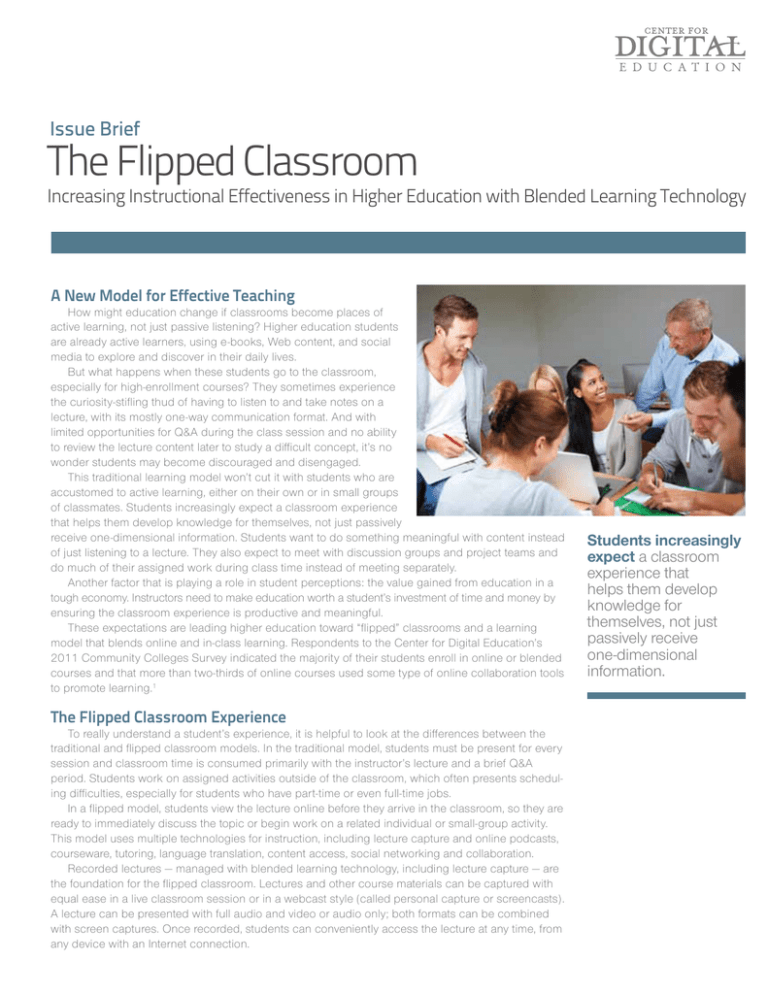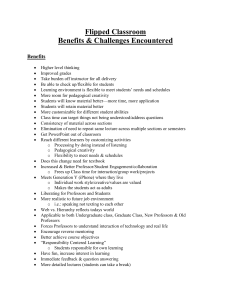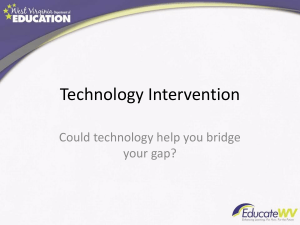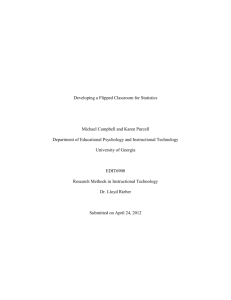
Issue Brief
The Flipped Classroom
Increasing Instructional Effectiveness in Higher Education with Blended Learning Technology
A New Model for Effective Teaching
How might education change if classrooms become places of
active learning, not just passive listening? Higher education students
are already active learners, using e-books, Web content, and social
media to explore and discover in their daily lives.
But what happens when these students go to the classroom,
especially for high-enrollment courses? They sometimes experience
the curiosity-stifling thud of having to listen to and take notes on a
lecture, with its mostly one-way communication format. And with
limited opportunities for Q&A during the class session and no ability
to review the lecture content later to study a difficult concept, it’s no
wonder students may become discouraged and disengaged.
This traditional learning model won’t cut it with students who are
accustomed to active learning, either on their own or in small groups
of classmates. Students increasingly expect a classroom experience
that helps them develop knowledge for themselves, not just passively
receive one-dimensional information. Students want to do something meaningful with content instead
of just listening to a lecture. They also expect to meet with discussion groups and project teams and
do much of their assigned work during class time instead of meeting separately.
Another factor that is playing a role in student perceptions: the value gained from education in a
tough economy. Instructors need to make education worth a student’s investment of time and money by
ensuring the classroom experience is productive and meaningful.
These expectations are leading higher education toward “flipped” classrooms and a learning
model that blends online and in-class learning. Respondents to the Center for Digital Education’s
2011 Community Colleges Survey indicated the majority of their students enroll in online or blended
courses and that more than two-thirds of online courses used some type of online collaboration tools
to promote learning.1
The Flipped Classroom Experience
To really understand a student’s experience, it is helpful to look at the differences between the
traditional and flipped classroom models. In the traditional model, students must be present for every
session and classroom time is consumed primarily with the instructor’s lecture and a brief Q&A
period. Students work on assigned activities outside of the classroom, which often presents scheduling difficulties, especially for students who have part-time or even full-time jobs.
In a flipped model, students view the lecture online before they arrive in the classroom, so they are
ready to immediately discuss the topic or begin work on a related individual or small-group activity.
This model uses multiple technologies for instruction, including lecture capture and online podcasts,
courseware, tutoring, language translation, content access, social networking and collaboration.
Recorded lectures — managed with blended learning technology, including lecture capture — are
the foundation for the flipped classroom. Lectures and other course materials can be captured with
equal ease in a live classroom session or in a webcast style (called personal capture or screencasts).
A lecture can be presented with full audio and video or audio only; both formats can be combined
with screen captures. Once recorded, students can conveniently access the lecture at any time, from
any device with an Internet connection.
Students increasingly
expect a classroom
experience that
helps them develop
knowledge for
themselves, not just
passively receive
one-dimensional
information.
Flipped Classroom Benefits
The flipped classroom experience makes optimal use of instructor
and student time, provides increased access to the instructor’s expertise and enables better scalability of instructional resources to support
high-enrollment demands. From the instructor’s perspective, key
benefits of the flipped classroom include:
• increased classroom time to present content, discuss complex
topics and work with students — either individually or in small
groups;
• reduced time spent answering basic and repetitive questions —
due to students’ ability to review lectures online;
• the ability to use recorded lectures in multiple course sections —
year over year, with easy tools for updating content; and
• quick adaptation of lecture content to respond to new
learning needs.
Student and Instructor Response
to Recorded Lectures
According to a recent university study,
lectures and other recorded content
increased student understanding of course
material, helped them prepare for tests and
improved test performance for some students.
Both a formal research study and informal student feedback
indicate a largely positive response among students and faculty to the
flipped classroom experience. The formal study, conducted by the
University of Sussex, identified the following key findings:2
• Lectures and other recorded content increased student understanding of course material, helped them prepare for tests and
improved test performance for some students.
• Students gave high ratings and viewership to videos and screen captures that explain key
concepts and help in test preparation. They also liked the option of resources in both video
and text form.
• Instructors required minimal support for creating their own recordings and would recommend
personal video capture tools to their colleagues. Barriers to faculty adoption were reduced
because they didn’t need to think about video file formats or storage issues.
However, some students feel the flipped model increases their workload compared to other
courses. This perception is especially true when the course involves more content and activities
and could be covered in a traditional approach. Instructors can easily reduce the workload burden
on students by reserving the flipped classroom model for certain lessons, or for only a few days out
of the week.
At North Arkansas College, 84 percent of students would like to see more
use of blended learning and lecture capture in their courses, noting:3
“I feel more
prepared
for class.”
“I like being able
to pause and
process [the
content].”
“[Blended
learning] makes
it possible to
review material
without wading
through hours
of vodcasts.”
The Flipped Classroom in Practice
The experience of several higher education institutions provides
valuable insights about using lecture capture technologies to flip
the classroom.
North Arkansas College
With 90 courses already recording lectures, Nor th Arkansas
College is creating more learning oppor tunities for students.
An added benefit: high-demand classrooms are now easier
to schedule because recorded lectures mean fewer
in-classroom sessions.
Space usage isn’t the only planning change resulting from
recorded lectures. “For instructors, the flipped classroom model
means they will need to rethink their teaching plans,” says Valerie
Martin, director of Distance Learning and Instructional Support. “What
will you do in the classroom if you’re not lecturing?”
Dr. Laura Berry, dean of Arts and Sciences notes, “Initially, our
faculty were big advocates for lecture capture technology and we had
to promote its value to the college’s executives and board of trustees.”
Today, the technology is proving its value with a six-fold increase in
blended learning classes offered by the college.4
“Our faculty want to make the most of their
Pace University
class time and students don’t want to spend
Lecture capture technology allows Pace University in New York
the
hour listening to a lecture. Because recorded
to maintain a competitive advantage and prepare for the global edulectures allow more interaction during class,
cation market of the future. “We know that recorded lectures are an
the face-to-face time with the instructor is more
important part of distance learning courses that can attract students
valuable for students.”
from around the world, who will add to the rich cultural experience
of the university,” says Shikha Bajracharya, director of user services
Mike Allington, Director of Technology Support Services,
for ITS.
The university’s 200 classrooms and lecture halls have lecture
St. John Fisher College
capture capability and personal capture software is available for all faculty. “We wanted to make the technology available immediately to any
instructor who requests it because it will help our students learn,” says
Antonio Soares, Jr., senior manager for educational media.
Another benefit: Instructors can record classroom content in advance for snow days and other
campus closures — no need to reschedule classes.5
St. John Fisher College
Also in New York, the nursing and pharmacy schools at St. John Fisher College make extensive use of lecture recordings to help students understand complex course content. To serve the
growing popularity of this technology, one system is installed on a mobile cart that can be moved
among classrooms.
“Our faculty want to make the most of their class time and students don’t want to spend the hour
listening to a lecture,” explains Mike Allington, director of Technology Support Services. “Because
recorded lectures allow more interaction during class, the face-to-face time with the instructor is more
valuable for students.”
The college’s instructors were initially concerned about protecting the intellectual property of their
lectures. However, they now see the potential for additional revenue when their lecture recordings are
used in online continuing-education courses.6
Worcester Polytechnic Institute
At the engineering and science-focused Worcester Polytechnic Institute in Massachusetts,
blended learning technology has been used in undergraduate level courses that have very complex
content and to help students prepare for lab experiments.
A survey conducted by one instructor indicated a mixed student response to the flipped
classroom model. “Some students dislike flipped courses where progress is measured through daily
assignments, instead of the traditional system of two or three major exams,” says Mary Beth Harrity,
director of the Academic Technology Center. “Other students like the regular feedback and increased
class time for hands-on activities.”7
Helping Faculty Make the Transition
The steps below are key in helping faculty make the
transition to the new model of a flipped classroom.
Identify the right uses. Some courses may not be suitable
for a flipped classroom model, such as courses with challenging
content that may benefit simply from making recorded lectures
available for later review by students.
Offer professional development and support. Inservice workshops, summer training programs and online
resources can help instructors understand their redefined
role, identify effective teaching methods for blended courses,
and learn techniques for using the lecture and personal
capture tools appropriately.
Choose the right technology. Faculty will be reluctant to
change their instructional model if doing so adds significantly
to their workload. A lecture capture solution should offer a clear
user interface and easy processes for instructors when they create and edit recordings, whether in a classroom or on their PCs.
Conclusion
The flipped classroom is a strategic direction that helps
higher education meet the expectations of today’s students
while optimizing teaching and classroom resources. The
blended learning approach of the flipped classroom can be
leveraged for both individual courses and on an organizational
level to improve instructional delivery and enhance student
achievement and satisfaction.
“At Pace University, we are very pleased with the
lecture capture capabilities. Our faculty members
are utilizing the lecture capture technology with
great success, and now our students are requesting
more usage of lecture capture in and out of
the classroom.”
Tom Hull, CIO, Pace University
Endnotes
1.
2.
3.
4.
5.
6.
7.
Center for Digital Education Webinar: “Digital Community Colleges Survey Overview:” http://www.convergemag.com/Digital_Community_
Colleges_Survey_Overview_10-27-11.html
University of Sussex Me2 U Project: http://www.sussex.ac.uk/elearning/audioandvideo/me2u
Center for Digital Education Webinar: “Tidbits About Blended Learning: Avoiding an Aversion to the Inversion of the Classroom,” featuring North Arkansas College: http://www.convergemag.com/events/webinars/Tidbits-About-Blended-Learning-Avoiding-Aversion-11-2-11.html
Ibid
Center for Digital Education interview with Antonio Soares, Jr. and Shikha Bajracharya, 1/20/2012
Center for Digital Education interview with Mike Allington, 1/17/2012
Center for Digital Education interview with Mary Beth Harrity, 1/20/2012
®
As a global leader in blended learning and lecture capture solutions, Echo360 helps higher education
institutions keep pace with modern students’ learning needs through products that digitally record and
upload learning content. Echo360’s products facilitate better instruction, lower costs and enrich learning
experiences by enabling students to easily access and share multimedia content. Through Echo360’s
platform, students can replay recorded sessions and review course information online at their convenience
and across various devices. More than 400 colleges and universities in 29 countries use Echo360’s
solution. For more information, visit www.echo360.com.
© 2012 e.Republic. All rights reserved.




